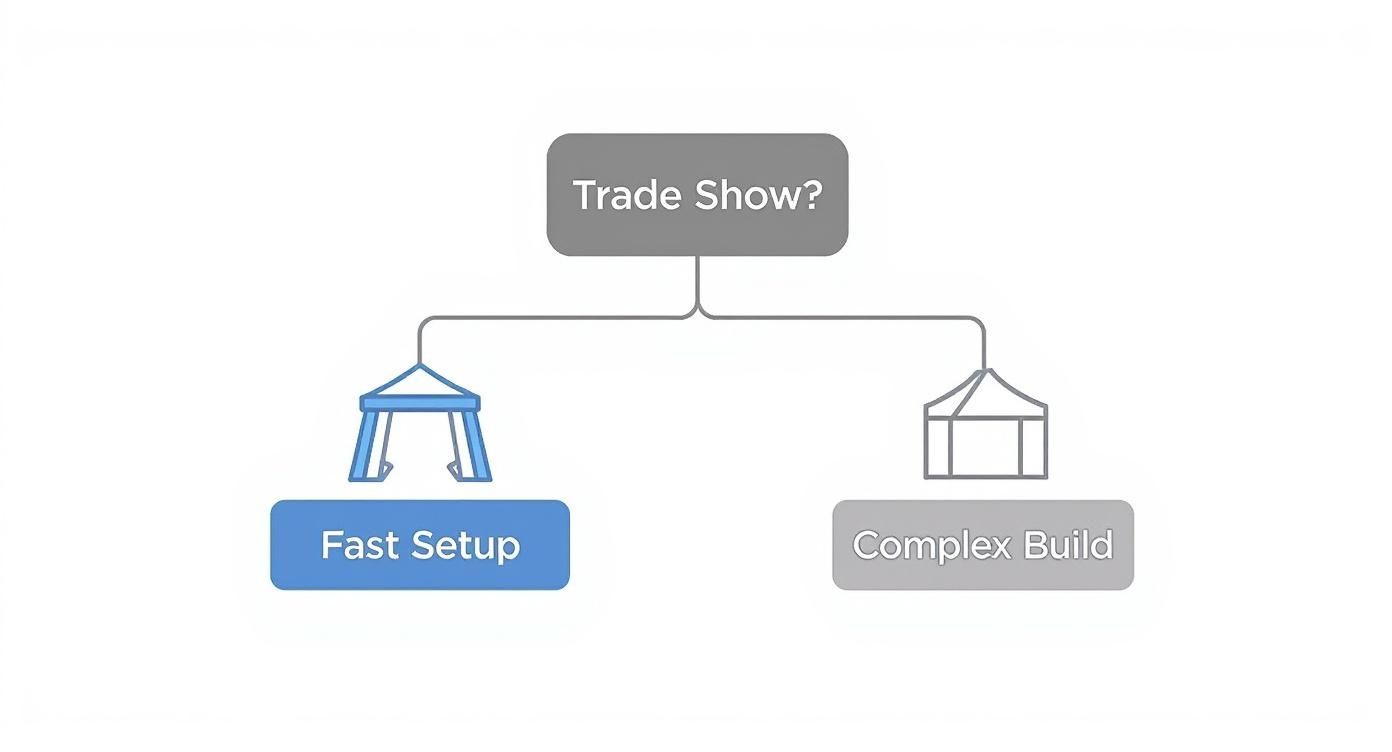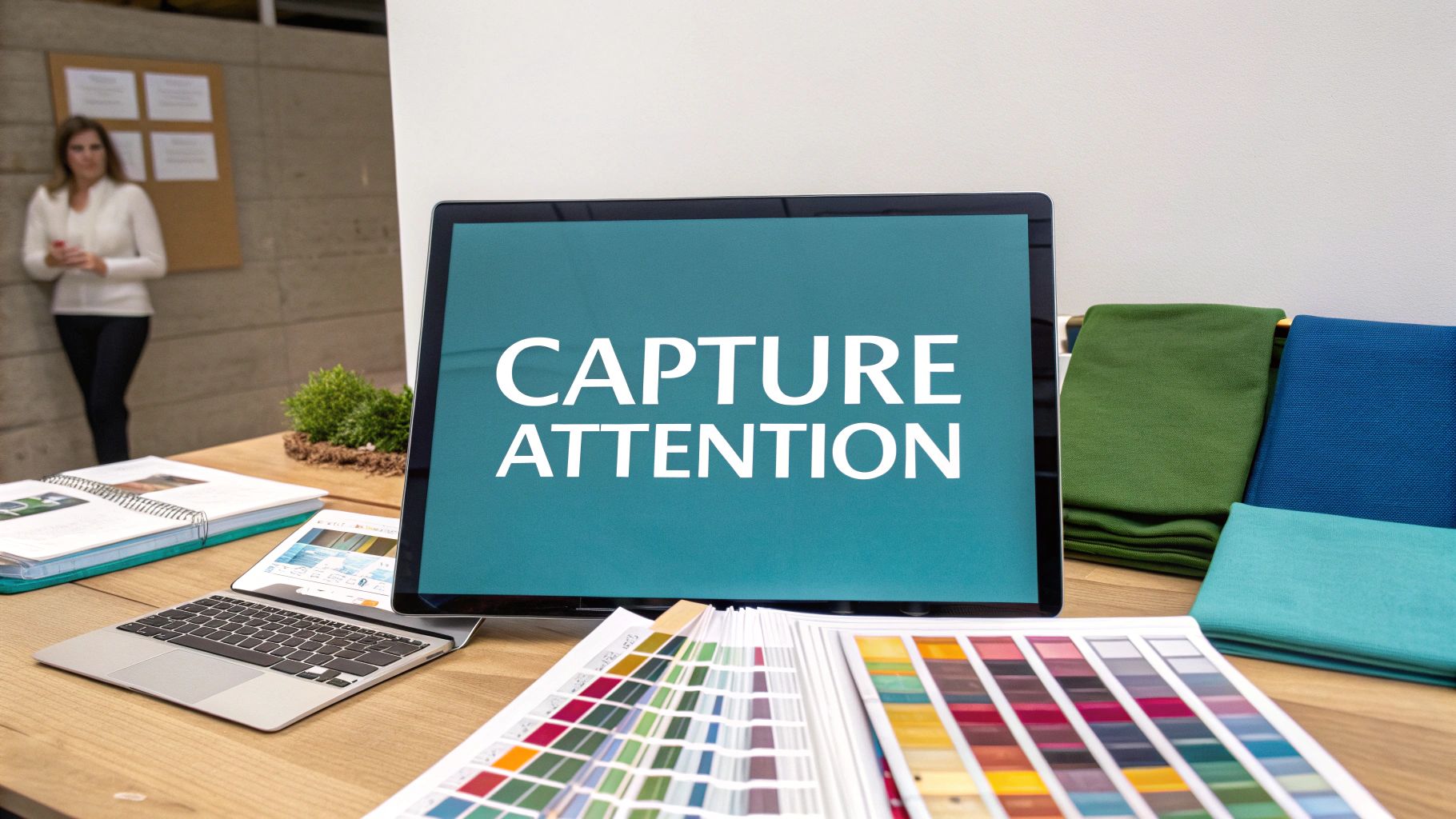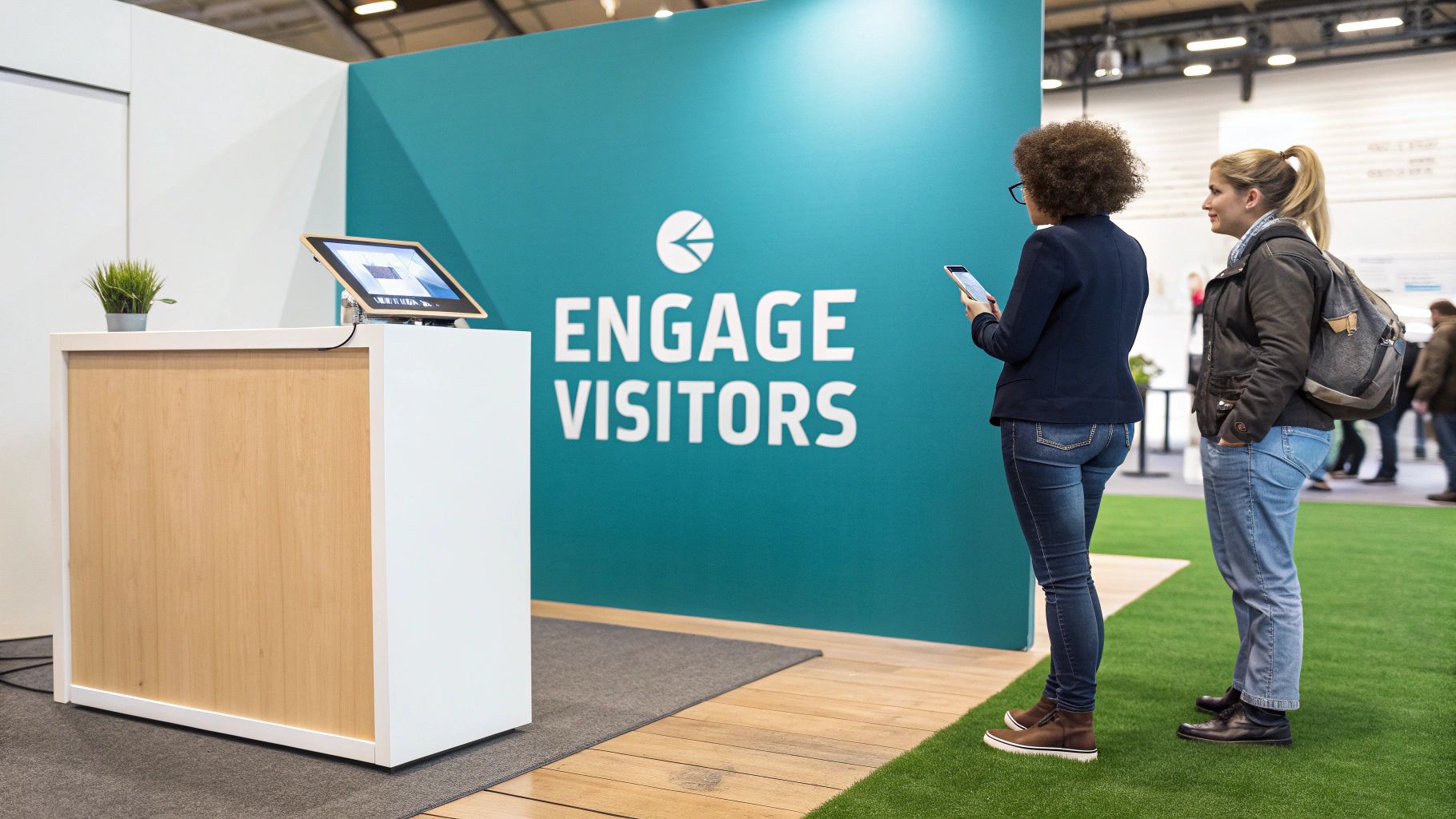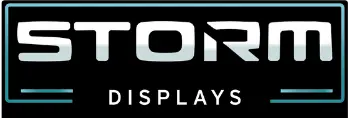You're a marketing manager tasked with making a splash at your next trade show. The problem? Your team is lean, your timeline is tight, and you don't have the budget for a massive, custom-built exhibit with a dedicated installation crew. How can you create a professional, eye-catching presence without the logistical headaches and astronomical costs? This is the exact challenge where a pop up display trade show booth becomes your most valuable asset.
Think of it as a professional-grade, portable backdrop system that’s built for impact but designed for simplicity. It all starts with a lightweight, accordion-style frame that literally pops open to form a large, sturdy structure. This frame becomes the perfect canvas for your vibrant, branded graphics. For any marketing team juggling tight deadlines, a pop up display is the key to creating a polished, professional presence in minutes, not hours.
The Power of a 15-Minute Setup
Picture this: you arrive at a chaotic convention center. Everywhere you look, other teams are struggling with massive crates, complicated instructions, and a general sense of panic. Now, imagine yourself breezing past them with a single wheeled case. You find your spot, open the case, and expand a stunning, full-size backdrop in less than 15 minutes. That’s the pop up display reality.
This effortless experience is exactly why so many event managers are ditching complexity for portability. A pop up display is engineered to solve the classic headaches of exhibiting: astronomical shipping fees, stressful setups, and the need for expensive hired labor.
Why the Industry is Shifting
Today’s trade show floor moves fast. Exhibitors need solutions that look amazing but are also incredibly efficient and budget-friendly. The old-school, traditional booths—with their heavy, cumbersome parts and mandatory setup crews—represent a huge drain on time and money. Pop up displays are the direct answer to those problems.
You can see this shift happening in the market data. The global demand for pop up displays has already pushed the market to a value of USD 4.1 billion. Analysts expect that number to climb, which just highlights how much brands want versatile, easy-to-manage solutions that make their lives simpler. For a deeper dive, you can explore the full report on pop-up trade show booth market growth.
A pop up display isn't just a backdrop; it's a strategic tool. It gives a small team the power to look like a major exhibitor, without the logistical nightmares or sky-high costs that usually come with it.
This move toward smarter displays allows companies to put their resources where they really matter. Instead of burning budget on freight and labor, you can invest in better pre-show marketing or interactive tech for your booth. Instead of wasting the first few hours of the show exhausted from setup, your team can be fresh and ready to connect with prospects the second the doors open. A pop up display is more than just hardware; it’s a competitive edge built on pure speed and simplicity.
Pop Up Display vs Traditional Booth At a Glance
To really see the difference, it helps to put them side-by-side. Here’s a quick comparison of how a modern pop up display stacks up against a more traditional booth setup.
| Feature | Pop Up Display | Traditional Booth |
|---|---|---|
| Setup Time | 10-20 minutes, usually by one person. | 4-8 hours+, requiring a professional crew. |
| Portability | Folds into a single, wheeled case. | Shipped in multiple heavy crates via freight. |
| Cost | Low initial investment and minimal shipping costs. | High upfront cost plus significant drayage fees. |
| Versatility | Excellent for various event sizes and spaces. | Custom-built for a specific footprint; less flexible. |
| Labor | DIY setup, no specialized labor needed. | Requires a union or specialized installation team. |
| Storage | Compact and easy to store in an office closet. | Requires significant warehouse or storage space. |
As you can see, the choice often comes down to balancing impact with practicality. While traditional booths offer unmatched customization for major shows, pop up displays provide a level of efficiency and cost-effectiveness that’s hard to beat for most exhibitors.
Choosing the Right Pop Up Display for Your Brand
Picking the perfect pop up display for your trade show booth isn't a one-size-fits-all kind of deal. What works for one brand might be completely wrong for another. The best choice really hinges on what you want to achieve at the event, your brand's personality, and the first impression you want to make on that busy show floor.
Think of it like dressing for an important meeting. A sleek, modern suit sends a very different message than a classic, buttoned-down one. In the same way, each style of pop up display says something unique about your brand before you even say a word.
This visual guide can help you get a feel for where your needs might land on the spectrum of display options.

As you can see, one of the first things to weigh is the trade-off between how fast you need to set up and how complex the build is—which is exactly where pop up systems shine.
Fabric Tension Displays for a Modern Look
If your brand is all about being clean, modern, and sophisticated, a Fabric Tension Display is probably your best bet. These displays use one large piece of stretch fabric that pulls tight across the frame, giving you a smooth, totally wrinkle-free backdrop.
The end result is a seamless, continuous image that just feels high-end and contemporary. Since the graphic is a single piece, it completely hides the frame, giving you a professional "mural" effect that looks way more permanent and polished than it actually is.
- Best For: Brands in tech, design, or professional services that want to project a sleek, minimalist vibe.
- Visual Impact: It creates a vibrant, matte finish that cuts down on glare from those awful convention hall lights, making it perfect for photos and videos.
- Setup Nuance: The fabric usually attaches with Velcro or just slips over the frame like a big pillowcase, so putting it together is incredibly straightforward.
Magnetic Panel Displays for Sharp Detail
For brands that rely heavily on sharp, high-resolution photos or lots of detailed text, the Magnetic Panel Display is the classic workhorse. This style is built from a series of individual graphic panels that snap onto the frame with magnetic bars.
This structure guarantees that every single panel lays perfectly flat, which means you get incredibly crisp lines and true photographic quality. If your booth features detailed product shots, complex infographics, or text you need people to actually read, the rigidity of magnetic panels ensures every detail is crystal clear.
The big win with magnetic panels is precision. The rigid structure means zero distortion, so complex logos and graphics look razor-sharp. This reinforces a brand image built on quality and attention to detail.
This is the go-to choice for companies that need to get a lot of visual information across quickly and clearly.
Backlit Pop Up Displays for Maximum Visibility
Let’s be honest, trade show floors are chaotic. When you need to stand out in a sea of visual noise, a Backlit Pop Up Display is your secret weapon. These displays use internal LED lights to illuminate a special fabric graphic from behind, making your whole booth literally glow.
That light acts like a magnet for eyeballs, drawing attendees to your booth from clear across the room. The effect is dramatic and professional, instantly elevating your presence and turning your booth into a can't-miss destination. It's a known fact that illuminated exhibits can significantly boost visitor engagement simply because they grab so much more attention.
- Best For: Any exhibitor who needs to command attention in a crowded space or wants to create a truly memorable, high-impact experience.
- Visual Impact: The backlighting makes colors explode with vibrancy and depth. Your message isn’t just seen, it's felt.
- Consideration: They're incredibly effective, but don't forget the obvious: backlit displays need power. Always confirm you'll have an electrical outlet at your booth space.
Once you understand what makes each style tick, you can pick the one that not only fits your logistical needs but also truly speaks for your brand.
Designing Graphics That Attract and Engage
Think of your pop up display as a giant billboard for your brand. In a crowded trade show hall, you have maybe three seconds to grab someone's attention before they walk right by. Your graphics are your single most important tool to stop traffic, tell your story, and pull qualified leads into your space.
Great design is more than just looking pretty; it’s a strategic conversation starter. The best graphics pass what I call the "glance test." Imagine someone walking down a busy aisle, 20 feet away. Can they instantly figure out who you are and what you do? If not, it’s time to rethink the design.

Mastering Visual Hierarchy and Messaging
One of the most common mistakes I see is exhibitors trying to cram their entire brochure onto their backdrop. Walls of text and dozens of bullet points create visual chaos, and people are wired to ignore that kind of clutter. Instead, you need a crystal-clear visual hierarchy that directs the eye exactly where you want it to go.
Think of your design in three simple layers:
- Top Layer: This is your company logo and a powerful, short headline. Make it big, bold, and place it high. This is what people see first from a distance.
- Middle Layer: A single, high-impact image or a couple of supporting visuals that tell a story. This should instantly communicate the benefit or feeling of your product or service.
- Bottom Layer: Any supporting text, like a brief tagline or a few key benefits, should be minimal. Keep the font large and stick to the upper half of the display where it's easily readable above any tables or people.
Your headline should be a quick punch—think five to seven words, max. The goal is to spark curiosity and start a conversation, not tell the whole story. Let your team handle the details in person.
Organizing your design this way makes your message digestible. You're respecting the attendee's time, which makes them far more likely to stop and engage.
Your Technical Checklist for Flawless Graphics
Even the most brilliant design concept can fall flat if the technical details are wrong. Blurry images or weird colors make your brand look amateurish. To avoid any printing day disasters, make sure your designer follows a strict technical checklist for the print-ready files.
Here’s what you need to get right every time:
- Resolution is King: Every image and logo needs to be at least 150 DPI at its full, final size. Anything less will look fuzzy and pixelated from a few feet away.
- Embrace CMYK: Your design files absolutely must be in CMYK color mode. RGB is for screens, CMYK is for ink. If you don't make the switch, your brand colors could look completely different on the final print.
- Mind the Safe Zone: Every template has a "safe zone." Keep all your critical text and logos comfortably inside it to avoid them getting cut off or wrapped around the frame.
- Understand the Bleed: The bleed is the extra bit of your design that extends past the final trim line. Your background images and colors need to fill this area completely to prevent any ugly white gaps along the edges.
As you plan, it's also worth thinking about how lighting can amplify your design. If you're considering a modern, immersive feel, take a look at how to choose the right backlit trade show displays, as their unique lighting can dramatically change your graphic needs.
Turning Your Pop Up Display Into an Experience
A brilliant pop up display is the heart of your trade show booth, but it's really just the beginning. To genuinely capture attention and pull in the right people, you need to think bigger. It's about transforming that patch of convention center carpet into a cohesive, inviting world that tells your brand's story.
This means looking beyond the backdrop. You have to consider how every single element—from your counter to your lighting—works together to guide, engage, and ultimately, impress everyone who walks by. The goal isn't just to set up an exhibit; it's to create an environment.

Maximizing Floor Space and Directing Traffic
Think of your booth's layout as its silent salesperson. How you arrange your display and furniture dictates how people move through and interact with your space. One of the most common mistakes is plopping a table right out front, which essentially builds a wall between your team and potential customers.
Instead, try this: push your pop up display to the back of the booth. Let it be the powerful visual anchor that draws the eye. Then, place your counters or kiosks off to the side. This simple shift creates an open, welcoming pathway into your area, encouraging people to step in rather than just peer in from the aisle.
Creating an impactful space is more critical than ever. With about 46% of companies attending only one trade show a year, you have to make every moment count. The fact that 95% of exhibitors still prefer in-person events shows just how much a memorable physical experience matters. If you're interested in the numbers behind these trends, you can discover more insights about trade show statistics.
Pairing Your Pop Up with Complementary Elements
A great pop up display truly comes to life when it's supported by a family of coordinated booth accessories. These pieces aren't just extras; they add crucial functionality, reinforce your brand identity, and give your booth a polished, professional look that builds instant credibility.
Here are a few key pieces to consider:
- Branded Counters: A portable counter gives you a natural home base for conversations and product demos. When its graphics match your backdrop, it creates a powerful, unified brand statement.
- Tablet Stands: Want to get people interacting? A sleek tablet stand is perfect. Attendees can browse your website, watch videos, or sign up for a newsletter on their own terms.
- Literature Racks: Keep your brochures and sell sheets from becoming a messy pile on your counter. A stylish literature rack keeps things organized and presents your materials professionally.
- Custom Flooring: Don't forget to look down! Interlocking foam tiles or custom-printed flooring can define your space, add comfort for your team, and sneak in another branding opportunity.
Your booth should feel like a small, self-contained world that reflects your brand. Every element, from the flooring to the counter, should work in harmony with your main pop up display to tell a single, consistent story.
To make sure you've covered all your bases, a quick checklist can be a lifesaver. Here are the core accessories you'll want to think about as you plan your booth layout.
Accessory Checklist for Your Pop Up Booth
| Accessory Category | Essential Items | Optional Upgrades |
|---|---|---|
| Greeting & Interaction | Branded Counter/Podium | Charging Station, Interactive Kiosk |
| Information Display | Literature Rack | Tablet Stand, Small Monitor |
| Comfort & Environment | Anti-Fatigue Mats | Custom Printed Flooring, Branded Chairs |
| Lighting & Ambiance | Clip-On LED Lights | Backlit Graphic Panels, Accent Spotlights |
| Logistics & Storage | Shipping Case | Case-to-Counter Conversion Kit |
Having these elements ready ensures your booth feels complete and functions smoothly, letting your team focus on what they do best: connecting with attendees.
Ready to make your next trade show easier and more impactful? The team at Storm Displays can guide you to the perfect pop up solution that fits your brand, your goals, and your budget.
Explore Our Pop Up Display Solutions or Request a Quote Today

